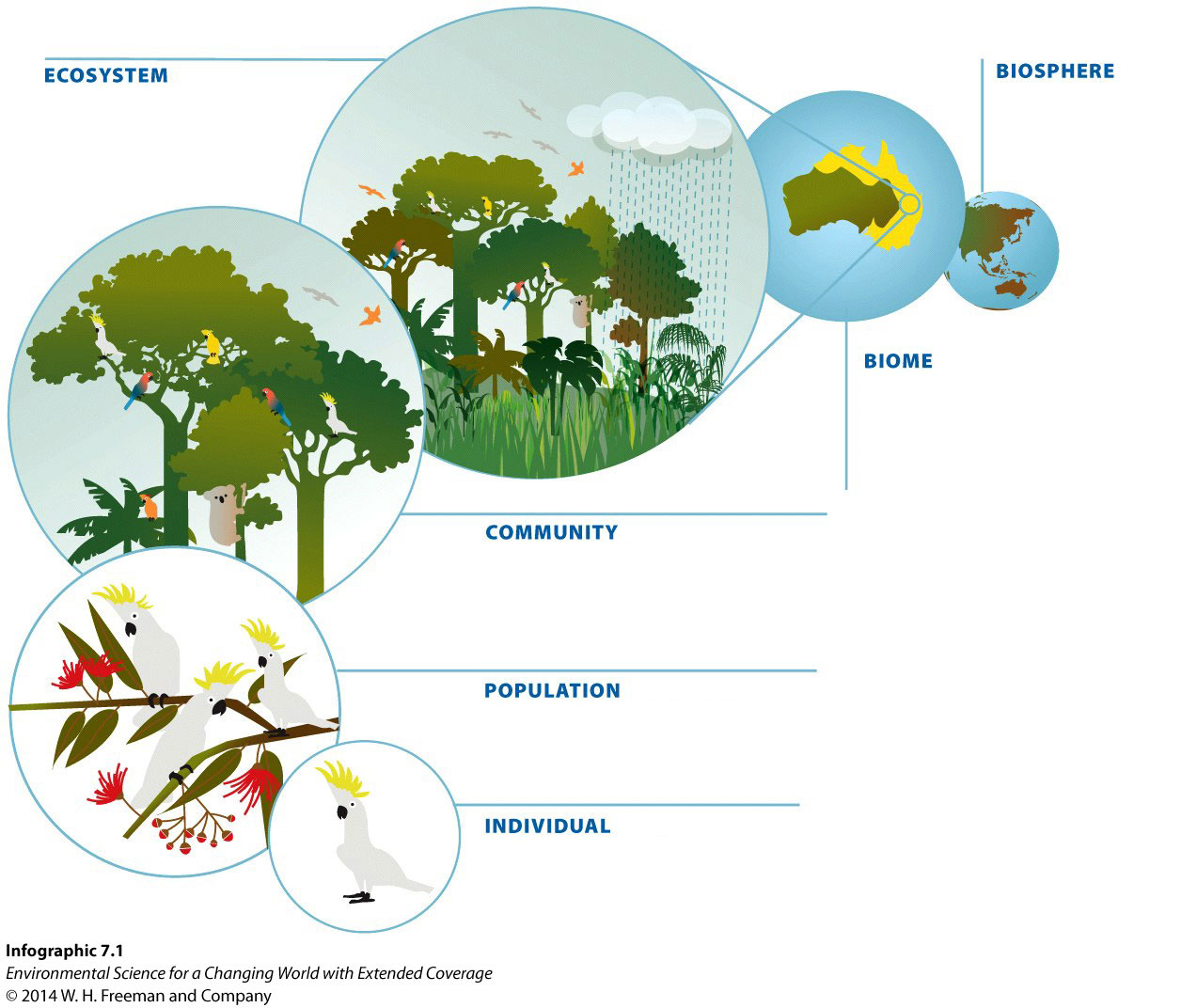Chapter 7. Chapter 7: Ecosystems and Nutrient Cycling
What is the hierarchy of organization recognized by ecologists...

Guiding Question 7.1
What is the hierarchy of organization recognized by ecologists, and why might it be useful to recognize such distinctions?
Why You Should Care
The biosphere and its parts as recognized by ecologists have been compared to living organisms, machines, and factories. Suffice it to say that they are made of many working parts. The different levels in the ecological hierarchy are arbitrary, but they provide a way to put order to something that is by its nature messy: life.
Question Test Your Vocabulary
Choose the correct term for each of the following definitions:
| Term | Definition |
|---|---|
| CSUpWRv9uQHoCswVD8HkwUd7/k67IaqRBb1owhCy+VZIbzO0HlJ9O/wp1pOwejBbGQCHumRg7ktdO8Gu2KLauYVqbx3zXwwtOtkhUxi1w0kUVAgii2CGkGdP6II90b2Q | The sum total of all of Earth's ecosystems. |
| U6eL9+GIFL5waITqv3FJe3XVmdOfn22V/YPH5PHXvuBPoSQD5MUvZUQlhmiuP7GQ5DNNCwcUTLxiIfO8k/JWlfRlDiQ6lXvL/utzm03PPZOzhrrLs1CxHr1IBQtPonqr | The physical environment in which individuals of a species can be found. |
| uBl0akrJ/aK+ZcWwJvRvldKQWG1JYtZkT7jHOtZAR1sVkGpkf2W3Se5vgZxbaDcFYFXEDd4MADO/S96mvpjLroQP729fkqTLo+hQNHCszkWBNmtwzM4mn02zb7RhgTbL | All of the organisms in a given area plus the physical environment in which they interact. |
| JIHTgoMc3PpaakNONU+LGA3gZMtcaiMCEsk79XFkn7VVJv4smUn6Op1qk2bd/Btt1mttHdUuAufLpUdflv1t/JaUC24wVMNFmTxwh0+WOodhiT0+Z2y6o+mo5KSYq/Cu | One of many distinctive types of ecosystems determined by climate and identified by the predominant vegetation and organisms that have adapted to live there. |
| 1BBGv0EC0Xpr4uOU0Q10z/EXzknOcE1HPhZLhlYgIJe1j79rOFdv731PK6wF9JJte9ANSxVgBmxzAVYR5durTM9uvDgvoqGS/RtPkw9JkdHqGJ3uFM9tow0LW/TM/5np | The role a species plays in its community, including how it gets its energy and nutrients, what habitat requirements it has, and what other species and parts of the ecosystem it interacts with. |
| iTC0+RJaWzlBGqhPhr30Ow8/LE7wI7dq2z9/2B4InMvCLixgBqszYxghCbK3Ini0GEViSIft1CbMhI45g3UX7mdzXRIdL2TmypAR27KXDRT7Pxo68iTOxZzH8GwoqDKK | A single member of the population. |
| lKqM+ywrLZAa6vGEa87F30M/Y1YUL8tCrZE/wM7tWeud2YjPOCKuS+X90UHfJNQP3bfCG+R8SiIGjNBUEbZzRA47YnpHeoNojb0gSxqToUVowhsk98gepi9POheY3IvU | A group of individuals of the same species living and interacting in the same region. |
| N/XQdSMS7LR61wvRm6i6k0B/QmuwHOWdltQzf/E0fC7hQE6TgGVNK4UPPvfkFLoAuaqy9yJlzTve4vYd7DVj6821XqRz60ZeaxJcJX26XyJFY5PN7lVkuuTY3QoYjHmy | A group of plants or animals that have a high degree of similarity and can generally only interbreed among themselves. |
| 7y6oxzIvCXLiTMy0IqlnD6vJMbBFHF8XkEUu7MFEPvxkAnI2VI4NOimugsxmWAMVYRTua/IEiIDDG0vvgY6L40qPIwJmiq4s/pGKLR/JeawcavfpukjbaGsj+IC4ZED8 | All the populations (plants, animals, and other species) living and interacting in an area. |

Question Sequence
Question 7.1
xagLQPa2KSGavRZWf+DSIz03N72o8KW/vRtIE+sbzzZoWfIFZVGxDpFxUq++Jjgl527hPpZzrOm1QW9MCuWY1UdnL5WGTFeTEenVP3/czhIacjML9GyJ++3ubnpOxEXQu39zxwt8gUvnJOdPpUH+RTrxHlsuaNdZqSW94kFVuHG8VEZsipWu6JNpKyv6BSlZrOm7Fwlx2Atq909lQuestion 7.2
Put the hierarchy of ecology in the correct order from least inclusive to most inclusive:
Least Inclusive
aznjUfKmlqUdQCup95aH5HYEk6W8nVa/vY+m8VVfLe0bKFfGbHeM0le0kFcKuwXnv94JSfCQcyRMeAzQXx9v016ENls=
Jy4iOnjVxP+uy3QLgwIxAZVL2eEWp4zn8Q0QZl9eI6mgc8v0+u2fTk3sseW0VHfIn+MNeNDF+VIVL5xfIuLl3A+labA=
rleO8EimLF7i2QqDH07Qz23A2ygKkrcsKDSVuEaGKF+L0BCKCO/z4Gidn88+yX6O0Xv1Q8knkhkJzd+Vb/b9jex/x30=
M7RFavZOTZt+K2W0uGGL7MciIZVgdITpHfiQb0wZVXha4wDU3NiGVBJbrSvXBltTY1WeXCZCI5MAJYcOiy0Og7vbHqk=
v7YnlbPHZvyqarEIEj3+3mYmhJfV6igqFBFN4PzNDyLvUjVArdiMrNZfLG9IvsMHjrmgXFYNJrzjktYBAoJJKXHwGNc=
UZkNA42rq/U8gSr0s++Y8cUcZvyZgvwlF5TBrb4yUsmiB1RbDVhVudxjA8j86O2GGzt33qSlf1YEUw7zopFGw6Gc5kg=
Most Inclusive
Question 7.3
sE4LNHJcde414ez71c+fL4yjhmnehTQl28tK+OYeATRtSzhEXqruWVJZ8qTfvYCMg+8xMbGWoAdQih15WX4OJN12caD7zG4b7wgt6t3dVUHIMIdMnAV2dEtZf2hyAUojPuxI4Uw7ppulUjX5MidJdYNkrZa7jCj3yg+Flja27wjUhCHAP637pQ7ZrwEl+3K3X4mP9s9QYd44GViK2owD7rOJt/E9FNmUdNc6ZlGfZ5AAwibre21vAcfAGYpaO4jXESymij8obH8dBFFprasRYN0LRQr/4o1dac+zkqBLVE6c6J4vIrAvSi68dd4429RBZuEhqgdtLZK7qrH8xaMmOtXgXa+ln/Utd/VYWl+kpPYo4TX3xhyWRlWanBpVnY5FlwmtFqx2fvQ9qlMooJaQMthfQSDgNl8/XZjoTZLKpjSCxzFWmXkXHWJGpuGV90IqEO6G+FZP0MK1hVgcFVn3P6GjylSWx1uE4x38eykUM7MP9Tfp5QtN7ZPOCXX7zdh9UQV0nHTw87RmVR8iX+pEwp2CRfLpnOdRD+jBkkGeRGkeeKiwI346eThhOp+c2ElWUx8cYmJ1Zd7p9iYCQuestion 7.4
j4U7v6WXvOVvjMz5+6Jf7rsH27bcU9vvVR0aTFmRuVSEfGxvJf6vUmKSVLO7Q7eVxv5ipjAzGn1Qb+zAzmIjfYXO38irexSGdFyYw78TT9/CgTgfBNni8IiijjDek4S4lXnSQuKAHeMKKat2GoTqfDmvUYOX6hchHsj3YTORAaSZG9La0rG8S3JSdC8qBmaybh/uyvhzI7w=Question 7.5 Apply Your Vocabulary
Read all of the following descriptions of parts of a hypothetical ecosystem; then go back and decide whether each depicts a species, habitat, or niche.
A) A single large tree in the rainforest with lots of branches. nyqN43/5xKh37rISHd45GteG2pNe11AIfi8w2/KhaMo=
B) Three-spot branch beetles live on this tree and others like it; they are similar to the four-spot branch beetle but breed at a different time of the year. c4c2J5ndxFYG9TP/RIoEVEQjdDDMYwFRSeEGlKRQ8Qc=
C) The three-spot branch beetles live on the branches, near the trunk, and eat the sap-sucking insects that live in that part of the tree. fs7NL4xSoXrRiC3U16lIM6kmCNUmF9RRqLR7GVlgI10=
Question 7.6
Decide whether the following passages describe a species' habitat or niche. Consider the perspective of the species listed in bold.
A) A salamander that usually lives under decaying logs. BUmIpclPLaKjfgk3x96r6NvGrmM=
B) A bird that feeds on the insects attracted to sap leaking from tree wounds. aDx5pX0sJ9xrbIawWpWIeaCuJsvcsd+/
C) A cactus species that only occupies areas that receive between 75 and 400 mm of rain per year. BUmIpclPLaKjfgk3x96r6NvGrmM=
D) A stingray feeds in the shallow areas near island beaches, where it feeds on sand-dwelling invertebrates that it senses with special electric-field and fluid-pressure detectors: aDx5pX0sJ9xrbIawWpWIeaCuJsvcsd+/
E) Giant Cecropia trees of the Central American rainforests provide anchoring points for many epiphytic (growing on other plants) plants and the animals adapted to live with them: aDx5pX0sJ9xrbIawWpWIeaCuJsvcsd+/
A) The answer is habitat because nothing is explained about what the salamander does under the logs. We don’t know what it eats, who eats it, and so forth.
B) The answer is niche because we learn specifically what sort of food the bird specializes in.
C) The best answer is habitat because we don’t know from this description what specifically keeps this cactus from competing with others or how it gets light.
D) The best answer is niche because we see that stingrays specialize in burrowing animals.
E) Although the Cecropia provides habitat for other organisms, that role is part of its niche.
A) The answer is habitat because nothing is explained about what the salamander does under the logs. We don’t know what it eats, who eats it, and so forth.
B) The answer is niche because we learn specifically what sort of food the bird specializes in.
C) The best answer is habitat because we don’t know from this description what specifically keeps this cactus from competing with others or how it gets light.
D) The best answer is niche because we see that stingrays specialize in burrowing animals.
E) Although the Cecropia provides habitat for other organisms, that role is part of its niche.